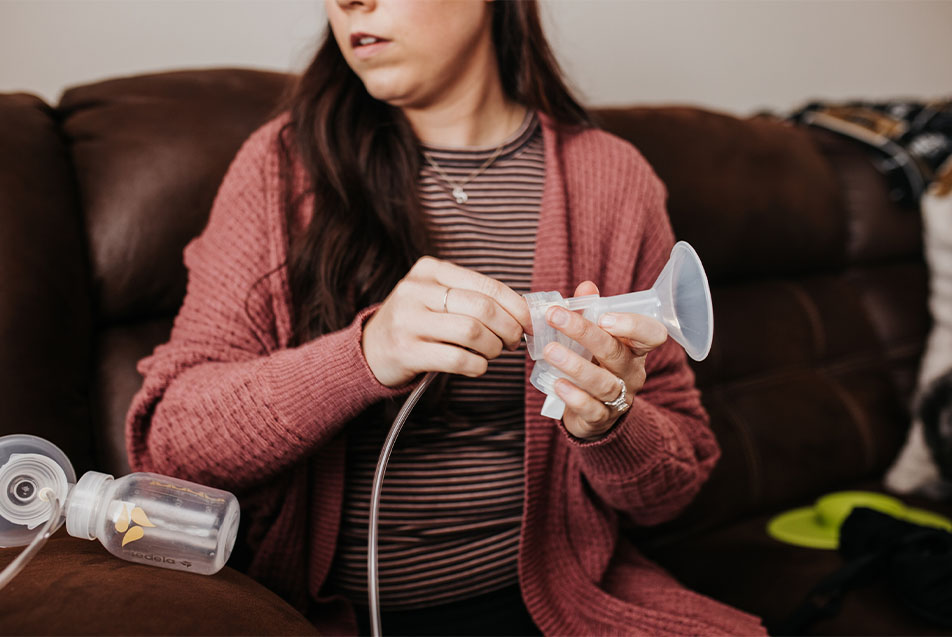
One of the most common reasons that mothers stop giving their infants breastmilk is issues with lactation, and these can often be tied to challenges related to pumping. Julie Schmucker, RN, IBCLC, lactation consultant, Parkview Women’s & Children’s Hospital Family Birthing Center, offers guidance pertaining to some of the most popular problems, and shares an exciting update regarding the Parkview Regional Medical Center’s offerings for breastfeeding mothers.
Concern: I think there is something wrong with my breast pump.
Start by asking a few basic questions. Does the machine turn on? Does it have suction? Some of the most common issues pertain to the pump’s settings, parts that need replaced and suction. I recommend reviewing the instruction manual, looking online for FAQs and troubleshooting information for the specific brand and model you are using.
Concern: I’m not getting enough suction.
If you are trying to pump and the suction is not working or is minimal, there are a few things to check:
- Is your flange (the cone-shaped funnel that fits directly over your nipple) against your breast all the way around to maintain suction?
- Do you have proper fit? Your nipple should go in the tunnel of the flange with 2-5mm of space. The suction should not pull the areola into the flange during pumping.
- Is your system assembled correctly? Is the membrane (the silicone barrier between the breast milk and the pump tubing) flat and properly seated to maintain suction? Is the duckbill valve pushed all the way on and closed to create suction?
- Do the parts need replaced? Keep in mind that the parts mentioned above need to be replaced every couple of months to maintain proper suction.
Concern: Pumping hurts!
Painful pumping is not normal. Please check your suction and flange size. More suction does not equal more milk. If you are in pain, it may inhibit your letdown and you will actually extract less milk.
There are a few things you can try to address discomfort. First, try to relax, use distraction and let the milk flow. Sit down, get set up to pump, take a breath and find a sense of calm. Watch a fun video of your baby if you are away.
The second thing I recommend is to make sure the flange fits correctly. Improper flange fit can cause edema (swelling) behind the nipple or nipple trauma and block milk flow. The flange should fit around the nipple and be just slightly larger to allow for free movement. It should not pull the areola (the thin pigmented skin around the nipple) in during pumping.
Concern: I don’t know if my breast pump is going to last.
With proper care, your pump can last your entire breastfeeding journey. It’s recommended to replace them as frequently as every year but that may not be necessary. Insurance will cover a new pump with each pregnancy.
Concern: Nothing is coming out when I pump.
The first question is how long has it been since you delivered? Following the birth of your child, colostrum may only provide drops in the first few days. Mature milk will come on days 3 to 5, earlier if you have breastfed previously.
The second thing to look at is whether or not you have suction. Troubleshoot your pump as outlined above.
And finally, I would encourage you to consider the frequency of your pumping sessions. Have you taken a break from pumping and are starting again? Sadly, your body can adjust quickly to decreased output which will reduce production. Have you been pumping at night? Prolactin is released at night and drives your milk supply. Eliminating nighttime pumping is the No. 1 cause of decreased milk supply.
Concern: I don’t know if I should keep trying to pump.
Did you just give birth? If so, yes! Keep pumping for the full 3 to 5 days after delivery. You will feel engorgement (inflammation of the breast) first and then the milk will come. If you have been feeding or pumping previously and your milk has stopped or significantly slowed production, reach out to your local lactation consultant. They can help address your personal situation. We can troubleshoot with you and help you establish the best plan for your continued breastfeeding goals.
Concern: I don’t know where to find replacement parts for my pump.
We are excited to now carry flange inserts in the gift shop at our Parkview Regional Medical Center location. If you need a smaller size flange, these universal inserts can help. While pump parts are not as readily available locally as they once were, most retailers that carry pumps have flanges and membranes for replacement. Other parts can be ordered online from the manufacturer or various distributors. You can also check to see if your insurance covers any costs for continued pumping expenses.
Concern: I’m feeling frustrated.
Breastfeeding is hard! Whether at the breast or pumping and bottle feeding, the process has a fair amount of challenges. Please give yourself some grace and think about your goals. How important is breastmilk to you? Is it a positive in your life, or draining on your mental health? Everyone has different goals, and your breastfeeding journey is your own. Do not compare yourself to the people or messages you see on social media. Normal daily output is 24 to 30oz of breastmilk, and output fluctuates throughout the day.
If you need anything or have questions, reach out to a lactation consultant for help. We are here to assist you in reaching your lactation goals, whatever that looks like.



